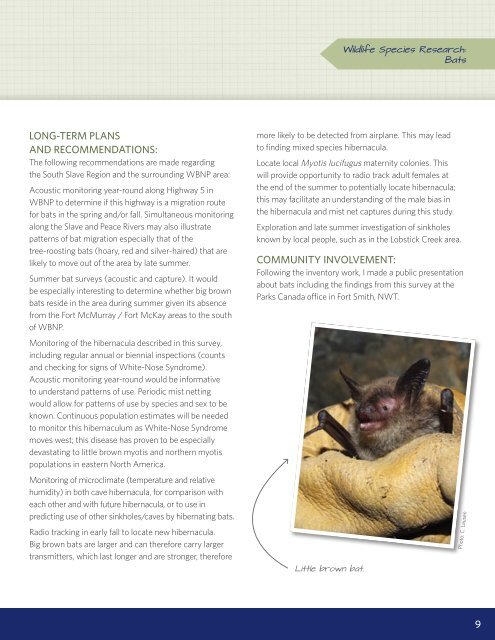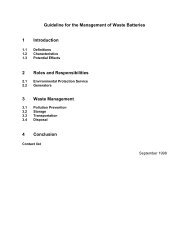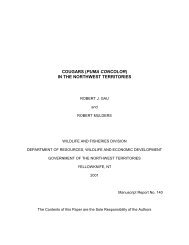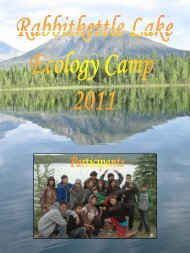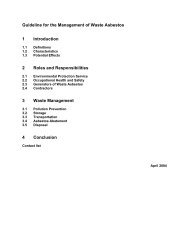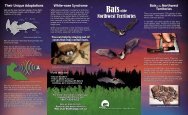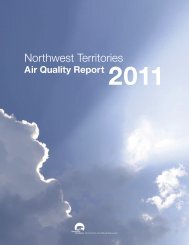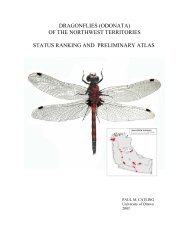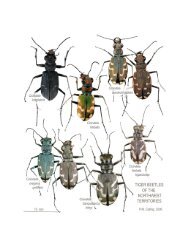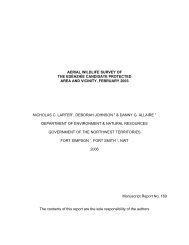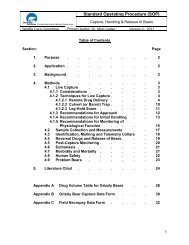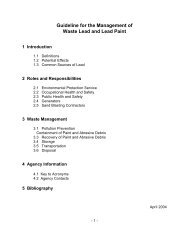2011 Annual Report of NWT Wildlife Research Permits and Western ...
2011 Annual Report of NWT Wildlife Research Permits and Western ...
2011 Annual Report of NWT Wildlife Research Permits and Western ...
Create successful ePaper yourself
Turn your PDF publications into a flip-book with our unique Google optimized e-Paper software.
<strong>Wildlife</strong> Species <strong>Research</strong>:<br />
Bats<br />
LONG-TERM PLANS .<br />
AND RECOMMENDATIONS:<br />
The following recommendations are made regarding<br />
the South Slave Region <strong>and</strong> the surrounding WBNP area:<br />
Acoustic monitoring year-round along Highway 5 in<br />
WBNP to determine if this highway is a migration route<br />
for bats in the spring <strong>and</strong>/or fall. Simultaneous monitoring<br />
along the Slave <strong>and</strong> Peace Rivers may also illustrate<br />
patterns <strong>of</strong> bat migration especially that <strong>of</strong> the<br />
tree-roosting bats (hoary, red <strong>and</strong> silver-haired) that are<br />
likely to move out <strong>of</strong> the area by late summer.<br />
Summer bat surveys (acoustic <strong>and</strong> capture). It would<br />
be especially interesting to determine whether big brown<br />
bats reside in the area during summer given its absence<br />
from the Fort McMurray / Fort McKay areas to the south<br />
<strong>of</strong> WBNP.<br />
Monitoring <strong>of</strong> the hibernacula described in this survey,<br />
including regular annual or biennial inspections (counts<br />
<strong>and</strong> checking for signs <strong>of</strong> White-Nose Syndrome).<br />
Acoustic monitoring year-round would be informative<br />
to underst<strong>and</strong> patterns <strong>of</strong> use. Periodic mist netting<br />
would allow for patterns <strong>of</strong> use by species <strong>and</strong> sex to be<br />
known. Continuous population estimates will be needed<br />
to monitor this hibernaculum as White-Nose Syndrome<br />
moves west; this disease has proven to be especially<br />
devastating to little brown myotis <strong>and</strong> northern myotis<br />
populations in eastern North America.<br />
Monitoring <strong>of</strong> microclimate (temperature <strong>and</strong> relative<br />
humidity) in both cave hibernacula, for comparison with<br />
each other <strong>and</strong> with future hibernacula, or to use in<br />
predicting use <strong>of</strong> other sinkholes/caves by hibernating bats.<br />
Radio tracking in early fall to locate new hibernacula.<br />
Big brown bats are larger <strong>and</strong> can therefore carry larger<br />
transmitters, which last longer <strong>and</strong> are stronger, therefore<br />
more likely to be detected from airplane. This may lead<br />
to finding mixed species hibernacula.<br />
Locate local Myotis lucifugus maternity colonies. This<br />
will provide opportunity to radio track adult females at<br />
the end <strong>of</strong> the summer to potentially locate hibernacula;<br />
this may facilitate an underst<strong>and</strong>ing <strong>of</strong> the male bias in<br />
the hibernacula <strong>and</strong> mist net captures during this study.<br />
Exploration <strong>and</strong> late summer investigation <strong>of</strong> sinkholes<br />
known by local people, such as in the Lobstick Creek area.<br />
COMMUNITY INVOLVEMENT:<br />
Following the inventory work, I made a public presentation<br />
about bats including the findings from this survey at the<br />
Parks Canada <strong>of</strong>fice in Fort Smith, <strong>NWT</strong>.<br />
Little brown bat.<br />
Photo: C. Lausen<br />
9


